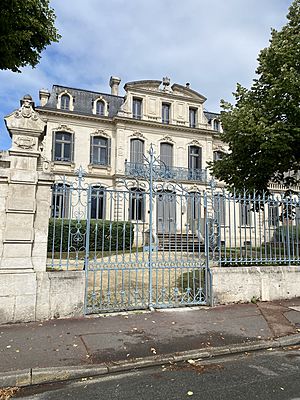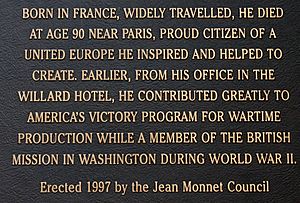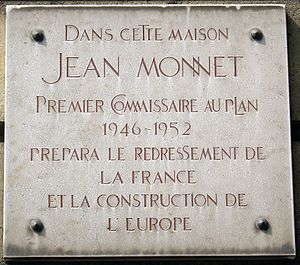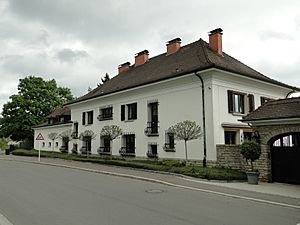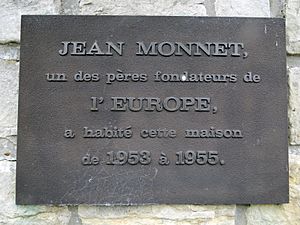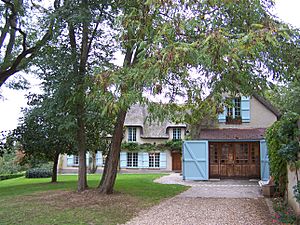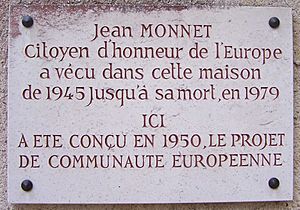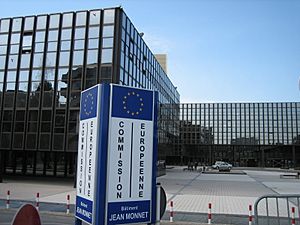Jean Monnet facts for kids
Quick facts for kids
Jean Monnet
|
|
|---|---|
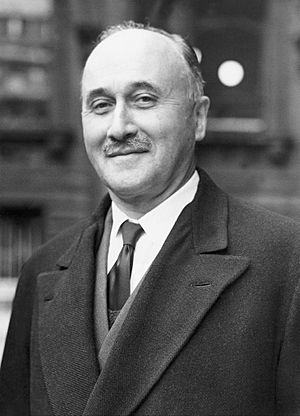
Monnet in 1952
|
|
| President of the High Authority of the European Coal and Steel Community | |
| In office 10 August 1952 – 3 June 1955 |
|
| Preceded by | Office created |
| Succeeded by | René Mayer |
| Commissioner of the French Plan Commission | |
| In office 3 January 1946 – 1952 |
|
| Preceded by | Office created |
| Succeeded by | Étienne Hirsch |
| Deputy Secretary-General of the League of Nations | |
| In office 10 June 1919 – 31 January 1923 |
|
| Preceded by | Office created |
| Succeeded by | Joseph Avenol |
| Personal details | |
| Born |
Jean Omer Marie Gabriel Monnet
9 November 1888 Cognac, Charente, France |
| Died | 16 March 1979 (aged 90) Houjarray, Bazoches-sur-Guyonne, France |
| Resting place | Panthéon, Paris, France 48°50′46″N 2°20′45″E / 48.84611°N 2.34583°E |
| Spouse |
Silvia de Bondini
(m. 1934) |
| Profession | Négociant, diplomat, public administrator |
Jean Monnet (9 November 1888 – 16 March 1979) was a French leader who helped create the European Union. He was a civil servant, a businessman, and a diplomat. Many people call him "The Father of Europe."
Monnet strongly believed that European countries should work together. His ideas in the 1950s led to the European Coal and Steel Community. This was the first step towards what is now the European Union. Even though he was never elected to a public job, he worked behind the scenes. He helped governments in America and Europe cooperate.
Jean Monnet and Charles de Gaulle, another important French leader, had a complex relationship. They worked together sometimes and disagreed at other times. Many people consider them two of the most important French people of the 20th century.
In 1976, Jean Monnet was given the special title of Honorary Citizen of Europe. This was a big honor for his work. In 1988, on his 100th birthday, his remains were moved to the Panthéon in Paris. This is a special building where famous French people are buried.
Contents
Early Life and Travels
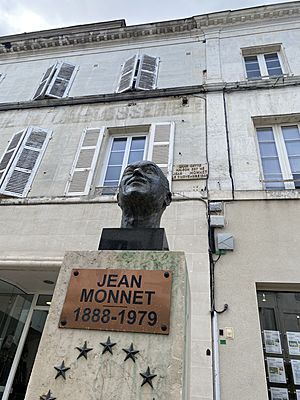
Jean Monnet was born in Cognac, France. His family were merchants who sold cognac, a type of brandy. His father, Jacques-Gabriel Monnet, ran the family business, which was called J.-G. Monnet & Cie. His mother, Marie Demelle, was very religious.
Monnet did not finish high school. Instead, he moved to London to learn about business. He worked for an agent of his family's company. After that, he traveled a lot for the business. He visited Canada, the United States, Scandinavia, and Russia. He also went to Egypt for health reasons.
Working During World War I
When World War I started in 1914, Monnet had an important idea. He believed that Britain and France needed to work together closely. He thought they should combine their resources to win the war.
Monnet convinced the French government that this was a good idea. He worked hard to get the Allied countries to cooperate more. Later in the war, his efforts led to better organization. For example, the Wheat Executive and the Allied Maritime Transport Council helped coordinate supplies. These efforts were very important for the war.
Between the World Wars
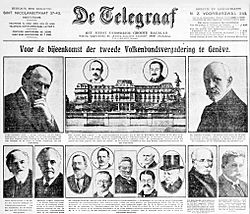
After World War I, Monnet helped at the Paris Peace Conference. He worked with the French minister of commerce. They suggested a "new economic order" based on European cooperation.
Because of his experience, Monnet was asked to be the Deputy Secretary-General of the League of Nations. This was a new international organization created in 1919 to promote peace. Monnet left the League of Nations in 1922. He felt he needed to help his family's cognac business, which was having problems.
Later, Monnet moved to America and worked in banking. He became an international financier. He helped several countries in Central Europe and Eastern Europe recover their economies. For example, he helped stabilize the money in Poland and Romania. In the 1930s, he also worked in China. He helped develop the Chinese economy and reorganize their railroads.
World War II Efforts
In September 1939, World War II began. The French Prime Minister sent Monnet to London. His job was to help organize war supplies between France and Britain.
In May 1940, France was invaded. Monnet suggested that France and Britain should form a single union. He believed they could only win if they fought as one. Winston Churchill and Charles de Gaulle supported this idea. However, the French government decided to make peace with Germany instead.
After France made peace, Monnet continued to help. Churchill asked him to get supplies from North America for Britain. Monnet became known for saying, "Better ten thousand tanks too many than one tank too few." He wanted a huge amount of weapons.
Monnet also became an advisor to President Franklin D. Roosevelt. He convinced Roosevelt to start a massive program to produce arms. This helped the American economy and supplied the Allies with military resources. British economist John Maynard Keynes later said that Monnet's work probably shortened World War II by a year.
In 1943, Monnet joined De Gaulle's French government-in-exile in Algiers. He became the Minister of Armaments.
The Monnet Plan for France
After World War II, France needed to rebuild. In 1946, Jean Monnet created a plan to help France's economy recover. It was called the "Monnet Plan." He was the first head of the General Planning Commission.
The Monnet Plan focused on making French industries bigger, more modern, and more efficient. It set ambitious goals for growth. Even though not all goals were met, the plan gave France direction and hope. It helped France start an economic boom in the 1950s.
This plan also led to a very important idea. It inspired French foreign minister Robert Schuman to suggest combining the French and German coal and steel industries. This idea became the European Coal and Steel Community, which was the start of the European Union.
Creating the European Coal and Steel Community

After World War II, there were tensions between France and Germany. They disagreed over who should control the important coal and steel industries. Monnet had a solution: he suggested they pool their industries together.
On 9 May 1950, Robert Schuman, the French Foreign Minister, made a famous declaration. This declaration, prepared by Monnet, proposed putting French and German coal and steel under a shared authority. Other European countries could join too.
This date, 9 May, is now celebrated as Europe Day by the European Union. It is seen as the beginning of the EU.
Negotiations based on the Schuman plan led to the Treaty of Paris (1951). This treaty created the European Coal and Steel Community (ECSC). France, West Germany, Italy, Belgium, Luxembourg, and the Netherlands signed it. In 1952, Jean Monnet became the first president of the ECSC's High Authority.
Action Committee for a United Europe
In 1955, Monnet started the Action Committee for the United States of Europe. He wanted to keep building European unity. This committee brought together political parties and trade unions. It pushed for new ideas that led to the European Union we know today.
These ideas included the European Economic Community (EEC) in 1958, also known as the "Common Market." Later came the European Communities and the European Parliament. This showed Monnet's belief in a gradual way to build European unity.
Monnet closed the Committee on 9 May 1975, exactly 25 years after the Schuman Declaration.
His Memoirs
Jean Monnet always wanted to write about his life and the ideas that guided him. He finally wrote his Memoirs in the early 1970s. They were published in 1976 and translated into English in 1978.
Private Life
Jean Monnet married Silvia Giannini in 1934. They met in Paris in 1929. Silvia was an Italian painter. They had two daughters, Anna and Marianne. The Monnet family returned to France in 1945. Silvia was a very important person in Jean Monnet's life.
Death and Burial
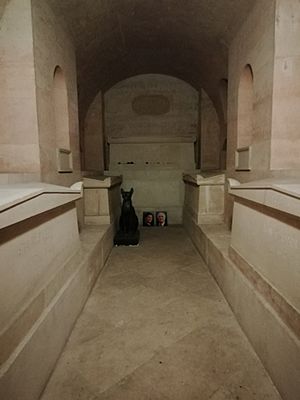
Jean Monnet passed away on 16 March 1979, at his home in Houjarray, France, at the age of 90. His funeral was attended by important leaders like the French President and German Chancellor.
On 9 November 1988, 100 years after his birth, his ashes were moved to the Panthéon in Paris. Many European leaders attended this special ceremony.
Honors and Recognition
Jean Monnet received many awards for his work. In 1953, he was given the Charlemagne Prize by the city of Aachen. This prize recognized his achievements in promoting European unity.
He also received honorary degrees from famous universities like Cambridge, Dartmouth, Yale, and Oxford.
In 1963, he was given the Presidential Medal of Freedom by the United States President. This is one of the highest civilian awards in the U.S. In 1972, Queen Elizabeth II made him an honorary Companion of Honour.
In 1976, he became the first person to be named Honorary Citizen of Europe by the European Council. This was for his amazing work to bring Europe together.
How He is Remembered
Jean Monnet is remembered in many ways across Europe.
Monuments and Plaques
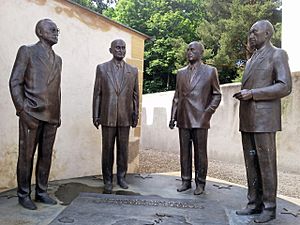
You can find statues and busts of Monnet in many cities. There are also plaques on buildings where he lived or worked. For example, there's a plaque at the Willard Hotel in Washington, D.C., where he had his office during World War II.
Jean Monnet House
Jean Monnet's home in Houjarray, France, is now a special place. It was there, in April 1950, that he and his team wrote the famous declaration that Robert Schuman used to propose the European Coal and Steel Community. Many important European leaders visited him there to discuss Europe's future. The European Parliament bought the house in 1982.
Places Named After Him
Many streets, squares, and bridges in Europe are named after Jean Monnet. For example, there's the Place Jean-Monnet in Paris and the Jean-Monnet-Strasse in Berlin.
Schools and Buildings
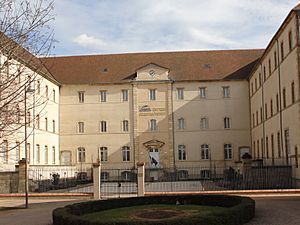
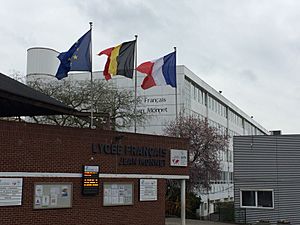
Many schools and universities are named after Monnet, including high schools in France, Taiwan, and Romania. The Jean Monnet University is in Saint-Étienne, France. The main building for the European Commission's activities in Luxembourg was also named the Jean Monnet Building.
Foundations and Programs
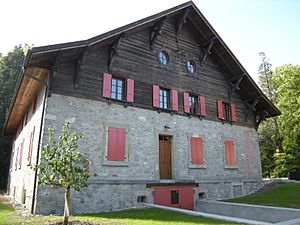
The Jean Monnet Foundation for Europe in Lausanne, Switzerland, helps promote European unity. It holds Monnet's personal papers and those of other important European figures.
The European Union also has the Jean Monnet Activities under Erasmus+. These programs help teach about European integration around the world, especially at universities. They support professors and researchers who specialize in European Union studies.
See also
 In Spanish: Jean Monnet para niños
In Spanish: Jean Monnet para niños


